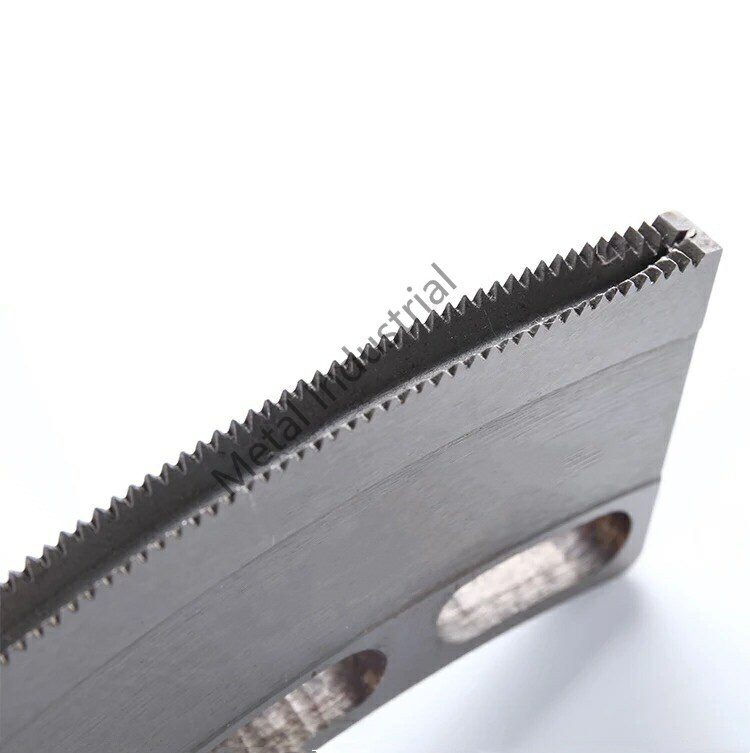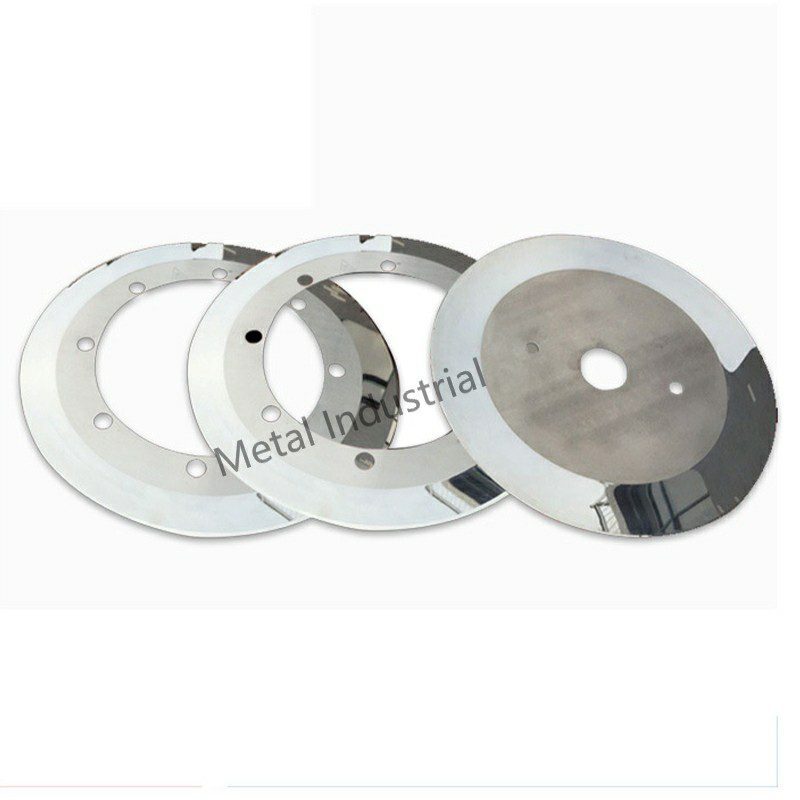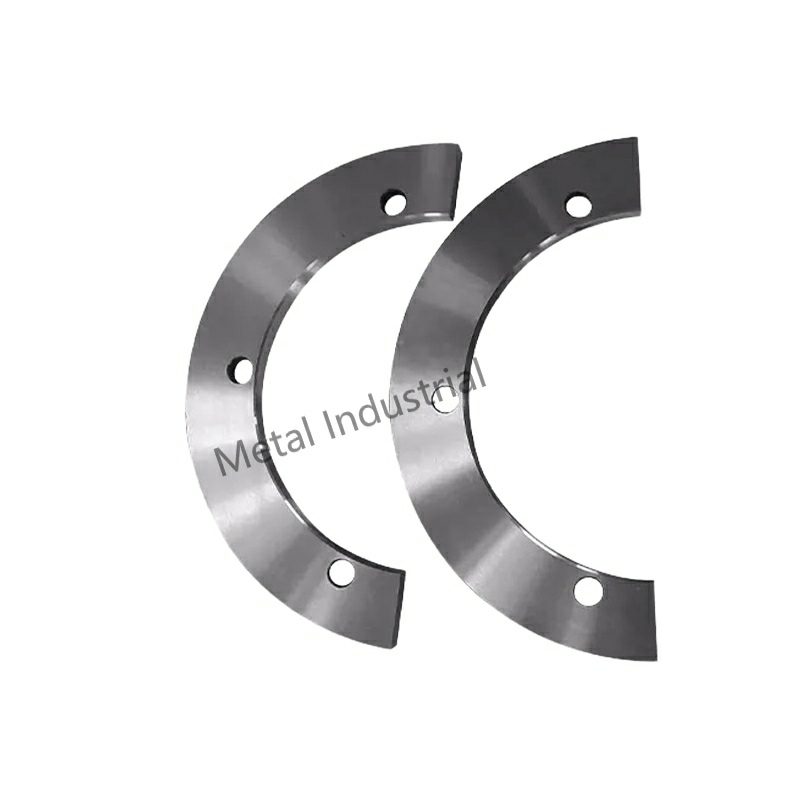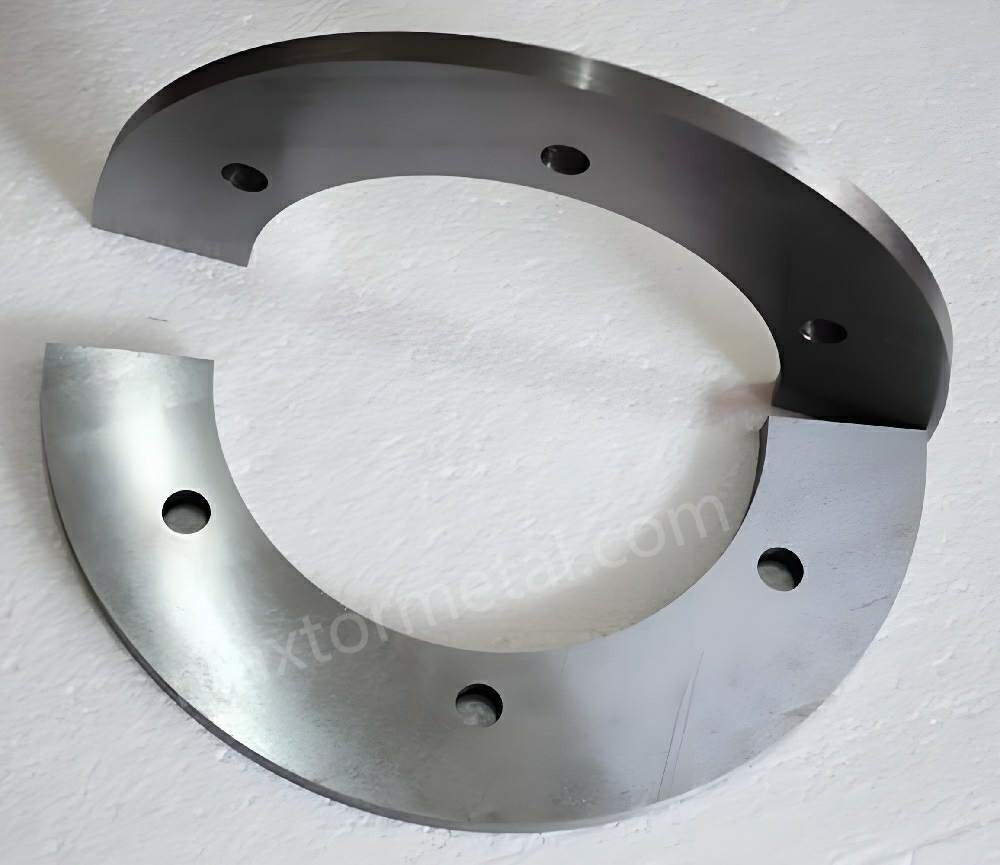
あなたには簡単なルールがあります スロッターマシンブレード切れ味が鈍くなったり、切れ味が悪くなってきたら研ぎましょう。ひび割れ、欠け、摩耗がひどい場合は交換しましょう。刃のお手入れは作業場の安全を守るだけでなく、費用の節約にもなります。以下の表で、刃のお手入れがどのように役立つかをご覧ください。
| メンテナンスアクション | 安全上の利点 | コスト削減のメリット |
|---|---|---|
| 頻繁な研ぎ | 刃の欠けや機械の危険を防ぎます | ダウンタイムと修理コストを削減 |
| 適切な清掃 | 蓄積と揺れを防ぐ | スロッターマシンの刃の寿命を延ばす |
重要なポイント
- 切り口が荒くなったり、刃先が鈍くなったりしたら、スロッターブレードを研いでください。振動が強くなったと感じたら、研いでください。研ぐことで、切り口がきれいになり、機械を安全に保てます。
- ひび割れ、欠け、反り、錆びが見られた場合は、すぐに刃を交換してください。これらの問題は、切断作業を危険にさらし、汚れを生じさせます。
- 刃は毎日、またはシフトの前に点検してください。切れ味が鈍っていないか、ひび割れていないか、あるいは粘着物が付いていないか早めに確認してください。
- 使用後は毎回刃を掃除し、ホコリ、糊、汚れを取り除いてください。刃詰まりを防ぎ、刃の寿命を延ばします。
- 刃の材質と使用頻度に応じて、決められたスケジュールで刃を研ぎましょう。これにより、切れ味の悪化を防ぎ、費用も節約できます。
- 超硬合金や高速度鋼などの適切な刃の素材を使用してください。これらの素材は長持ちし、研ぐ手間も少なくなります。
- メンテナンスログを保管し、チェックリストを使って刃の状態を監視しましょう。これにより、刃を研ぐ時期や交換する時期を把握しやすくなります。
- 刃の選び方、研ぎ方、お手入れのヒントなどについては、Nanjing Metal のセールス エンジニアなどの専門家にご相談ください。
スロッターマシンブレード:その決定が重要な理由

切削精度と品質
カートンスロッターブレードは、きれいにまっすぐなカットを可能にします。鋭い刃はボードをきれいにカットします。これにより、箱は丈夫できれいな状態を保てます。刃が鈍いと、端が荒れたり、破れたりします。これらの問題は箱の強度を低下させ、場合によっては使用中に箱が破損することもあります。
の 刃の材質と切れ味 良いカットには非常に重要です。いくつか例を挙げます。
| ブレード材質 | 切断精度への影響 | 切れ味と耐久性に関する注意事項 |
|---|---|---|
| 高炭素鋼 | 最初から鋭い切れ味を保ち、よく切れる | 頻繁に研いだり交換したりする必要がある |
| 合金鋼 | 硬くて丈夫で、切れ味が持続します | たくさんの箱を作るのに適しています |
| セラミック | 非常に硬く、すぐに鈍くならない | 非常に鋭い刃が必要な作業に最適 |
刃は、板の波型部分にフィットすると最もよく機能します。これにより、切りやすくなり、刃の欠けも防ぎます。刃を適切な角度で研磨することも効果的です。刃が鋭いと、切り口のざらつきが少なくなり、切り口がきれいになります。箱の見た目も良くなり、長持ちします。
ダウンタイムと生産コスト
刃が鈍っていたり壊れていたりすると、機械の速度が低下したり停止したりします。修理や刃の交換が必要になり、時間がかかります。その結果、箱の生産量が減少し、納期に間に合わなくなる可能性があります。刃の調子が悪いと、切り口が悪くなり、板材の無駄が増えてしまいます。
方法は次のとおりです 刃の形状と切れ味によってコストが変わります:
| スロッターブレードの状態 | 生産とコストへの影響 |
|---|---|
| 刃先が鈍い、または不規則なため、刃先が粗くなる | 苦情が増え、仕事が遅くなり、問題解決に時間がかかる |
| 刃のメンテナンスが行き届いており、滑らかな切れ味を実現 | 顧客満足度の向上、作業の高速化、待ち時間の短縮 |
| ブレードの品質とメンテナンスの向上 | お金を節約し、無駄を減らし、より効率的に働く |
良い刃を購入して 鋭い状態を保つことでお金が節約できる機械の高額な修理費も回避できます。Metalは刃を丁寧に点検し、強度の高い素材を使用しています。これにより、ダウンタイムやミスが減り、作業がスムーズに進みます。
安全上のリスク
スロッターマシンの刃が鈍くなったり、破損したりすると危険です。ひび割れや欠けのある刃は、使用中に破損する可能性があります。これにより、人を傷つけたり、マシンを損傷したりする可能性があります。刃が鈍いと、力を入れる力が強くなり、怪我をする可能性があります。
次の安全上の問題に注意してください。
- ひび割れや欠けのある刃は突然壊れることがあります。
- 刃が鈍いと、切り口が荒くなり、大きな音が出ます。
- 錆や腐食により刃が弱くなり、安全性が損なわれます。
- 過熱したり位置がずれたりすると、刃が曲がって事故につながる可能性があります。
作業員全員の安全を守るため、刃は頻繁に点検し、必要に応じて交換してください。刃を丁寧に扱い、Metalのような良質の刃を使用することで、事故を防ぎ、作業場を安全に保つことができます。
ヒント:ブレードの点検は必ずスケジュールに従ってください。ブレードを良好な状態に保つために、ブレードの専門家にご相談ください。
より良いカット、ダウンタイムの短縮、そしてより安全なチームワークをお求めなら、Metalのスロッターマシン用ブレードをお試しください。もっと詳しく知りたいですか? 南京Metalの営業エンジニアにお問い合わせください 助けを求めて。
カートンスロッターブレード:摩耗パターン

鈍いエッジ
鈍いエッジ カートンスロッターの刃の摩耗の一般的な兆候です。刃先が鋭くないと、箱の切り口が粗くなったり、ぼやけたりします。これはカートンスロッターの刃とプリンタースロッターの刃の両方で発生します。刃先が鈍いと、機械でうまく切れなくなります。刃は中央または端の方が摩耗しやすい場合があります。
鈍いエッジがどのように見えるか、またそれがなぜ発生するかを示す表を以下に示します。
| 鈍いエッジパターン | 原因 | 切断精度への影響 |
|---|---|---|
| 鈍くなっても | 長期間にわたる通常の使用 | 切断精度が低い、粗い切断 |
| 中心の鈍化 | 中央の圧力が高すぎる | 不均一なスロット、弱いボックス構造 |
| 鈍化を終わらせる | ずれや不均一な圧力 | ほつれた端、フィット感が悪い |
| フェザーエッジ | ブレードの摩耗と材料の蓄積 | スロットのサイズが一定でなく、カットが不鮮明 |
定期的なメンテナンスの際に、これらの兆候がないか確認してください。刃先が鈍くなると、切りにくくなり、刃の摩耗が早まります。これらの兆候が見られたら、刃を研ぐか交換して問題を解決してください。
ひび割れや欠け
ひび割れや欠けは深刻な問題であり、早急に修理する必要があります。これらは、段ボール用スロッターブレードとプリンター用スロッターナイフの両方に発生する可能性があります。ひび割れは、ブレードが急激に熱くなったり冷たくなったり、衝撃を受けたりすることで発生することがあります。欠けは通常、ブレードを頻繁に使用したり、ボードの硬い部分にぶつけたりすることで発生します。
この表では、ひび割れや欠けの主な種類、その原因、ブレードに与えるダメージについて説明します。
| ダメージタイプ | 主な原因 | 説明と効果 |
|---|---|---|
| 熱分解 | 急激な加熱または冷却、熱衝撃 | 刃先にひび割れが生じ、切断精度が低下し、破損の危険性がある |
| チッピング | 機械的衝撃、繰り返しのストレス、疲労 | 小さな破片が折れてギザギザの切り傷や摩耗の原因となる |
| 局所的な崩壊 | 材料強度を超えると塑性変形 | 刃先が曲がったり折れたりして、切断精度が低下する |
ひび割れや欠けがあると、カートンスロッターの刃は安全に使用できなくなります。また、スロットの不具合を引き起こし、機械を故障させる可能性もあります。安全のために、これらの問題が発生した刃はすぐに交換してください。
振動とチャタリング
振動やガタガタ音は、カートンスロッターブレードまたはプリンタースロッターナイフに何らかの問題があることを示しています。カタカタ音やブーンという音が聞こえる場合は、機械が振動している可能性があります。これは、ブレードが摩耗している、正しく取り付けられていない、または部品が緩んでいる場合に発生する可能性があります。また、ブレードの取り付けが間違っている場合や、ブレードが柔らかすぎる場合にも、ガタガタ音が発生することがあります。
振動やガタつきがあると、まっすぐ切るのが難しくなり、刃の摩耗が早まります。箱の溝が波打ったり、凹凸になったりすることもあります。これらの問題は、機械の他の部品を損傷させる可能性もあります。専用の工具を使うと、 振動を確認する どれくらい強いか確認してください。これらの兆候を確認することで、問題を早期に発見することができます。
ヒント: 振動やガタガタ音が聞こえたら、機械を停止してカートンスロッターの刃を点検してください。問題を早期に解決することで、コストを節約し、きれいなカットを保つことができます。
これらの摩耗パターンを把握することで、ラインを良好な状態に保つことができます。定期的な点検を行うことで、問題が悪化する前に発見することができます。
カーフ幅の拡大
カートンスロッターの刃の切れ目が広がっているのは、明らかにメンテナンスが必要なサインです。箱のスロットの上部が下部よりも広くなっていることに気づいたら、刃のカットに問題がある可能性があります。この問題は、スロットの底部が不均一な状態として現れることがよくあります。スロットの上部は問題ないように見えても、底部がまっすぐでなかったり、狭かったりすることがあります。また、角の部分が曲がっている場合、刃がきれいに切れていないことを意味します。
- カーフが広がると、次のような問題が発生する可能性があります。
- スロットの底が不均一なので、ボックスが弱くなります。
- 角が曲がったカットのため、フィット感が悪くなります。
- スロットの上部が下部よりも大きい寸法エラー。
- 特に細かい作業にプリンターのスロッターナイフを使用する場合、スロットのサイズを正確に保つのが困難です。
この問題を解決するために、送り速度を遅くしたり、カット高さを下げたりしてみるのも良いでしょう。しかし、これらの変更はあまり効果がありません。カーフが広がるのは、通常、カートンスロッターのブレードが摩耗しすぎているか、ブレードの角度がずれていることを意味します。場合によっては、ドッグボーンスロットを追加するなど、ブレードの設計を変更することで、より良い結果が得られることもあります。この問題が頻繁に発生する場合は、ブレードの摩耗を確認し、必要に応じて交換してください。
ヒント: スロットのサイズは必ず上から下まで確認してください。大きな違いがある場合は、すぐにカートンスロッターのブレードを点検してください。
フィードジャム
カートンスロッターの刃がボードをスムーズに機械内に送り込めなくなったときに、フィード詰まりが発生します。この問題は、多くの場合、刃の摩耗や損傷から始まります。刃先が鈍くなったり欠けたりすると、ボードをスライスする代わりに、ボードを掴んでしまいます。その結果、ボードが動かなくなり、詰まりが発生する可能性があります。
渋滞の前に、次のような兆候に気付くことがあります。
- 機械の速度が低下したり、奇妙な音がしたりします。
- 刃の部分に板が引っかかったり積み重なったりします。
- 完成した箱の端がざらざらしていたり、破れていたりします。
フィード詰まりは時間と材料の無駄になります。また、プリンターのスロッターナイフやその他の機械部品に余分な負担をかけます。頻繁に詰まりが発生する場合は、刃の摩耗や、カートンスロッターの刃に欠けや鈍い部分がないか確認してください。刃を交換または研磨することで問題を解決し、生産ラインをスムーズに稼働させることができます。
フィード詰まりを避けたい場合は、シフトごとにブレードを点検し、鋭い状態に保ってください。
残留物の蓄積
カートンスロッターブレードでは、残留物の蓄積がよくある問題です。切断中に、埃、接着剤、紙片などがブレードに付着することがあります。この蓄積により抵抗が大きくなり、ブレードがきれいに切れなくなります。以下の原因で切断品質が低下することがあります。 5–10% 刃を頻繁に掃除しないと、
残留物が蓄積すると、次のような問題が生じます。
- 摩擦が増すため、ブレードの摩耗が早くなります。
- 切断精度が低いため、箱の見た目が粗くなります。
- カートン スロッター ブレードとプリンター スロッター ナイフをより頻繁に研いだり交換したりします。
ブレードはシフトごとに少なくとも1回は清掃してください。埃っぽい環境では、より頻繁に清掃してください。圧縮空気または柔らかいブラシを使用して、ブレードを傷つけずにゴミを取り除きます。ブレードシャフトやベアリングなどの可動部品には、摩耗を防ぐため、48時間ごとに潤滑油を塗布してください。これらの手順を省略すると、ブレードの摩耗が進み、メンテナンスコストが増加します。
注記: 定期的な清掃と潤滑により、カートン スロッターの刃の寿命が長くなり、切れ味が鋭くなります。
生産ラインをスムーズに稼働させ、箱を最高の状態に保ちたい場合は、これらの摩耗パターンに細心の注意を払ってください。
刃の研ぎ方:いつ、どのように

研ぎ澄まされた兆候
スロッターマシンの刃の研磨時期を把握しておくことが重要です。適切な時期を逃すと、切れ味が悪くなったり、材料が無駄になったりするリスクがあります。毎日の点検で、以下の兆候に注意してください。
- 段ボール箱の切り口がギザギザしていたり、不均一だったりする場合は、刃先が鈍くなっている可能性があります。これは、切断精度の低下につながります。
- 運転中の騒音や振動が増加する場合は、ブレードのバランスが崩れているか損傷している可能性があります。また、機械に損傷を与える可能性もあります。
- 目視検査で見つかった目に見える傷、ひび割れ、または鈍いエッジは、ブレードの物理的な損傷を示しています。
- 切断速度が遅いと刃が鈍くなります。作業時間が長くなり、コストが上昇することもあります。
これらの兆候を無視しないでください。もし一つでも兆候が見られたら、すぐに刃を研ぐ計画を立ててください。刃を鋭く保つことで、きれいな切り口が得られ、マシンの良好な動作を維持できます。
ブレードの状態の評価
刃の状態は、いくつかの簡単な手順で確認できます。まず、マシンの電源を切り、刃を安全に取り外します。刃先をよく見てください。光沢のある部分、欠け、または丸みを帯びた刃先が見られる場合は、研ぐ必要があります。刃先に沿って指で優しくなぞってみてください。鋭い刃は滑らかで均一な感触です。鈍い刃は、ざらざらとした感触や小さな突起があります。
ひび割れや欠けがないか確認してください。もし見つかった場合は、研いでも効果はありません。刃を交換する必要があります。また、糊、ほこり、紙などが付着していないか確認してください。研ぐか交換するかを判断する前に、刃をきれいにしてください。
虫眼鏡を使えば、小さな傷やバリを見つけることができます。もし見つけたら、研ぐことで刃の切れ味を回復させることができます。刃物を取り扱う際は、必ず機械の安全規則に従ってください。
シャープニング間隔
スロッターマシンの刃は定期的に研磨する必要があります。これにより、切断面をきれいに保ち、マシンを安全に保つことができます。適切な研磨間隔は、マシンの使用頻度と刃の種類によって異なります。Metalの高品質な素材(工具鋼やタングステン鋼など)は、刃の鋭さを長持ちさせます。そのため、一般的な刃ほど頻繁に研磨する必要がない場合があります。
8~10時間ルール
多くのオペレーターは8~10時間ルールに従っています。8~10時間ごとに刃を点検し、必要に応じて研磨する必要があります。このルールはほとんどの生産ラインで有効です。Metalの超硬チップ付き刃を使用すれば、研磨間隔を長くできる場合があります。機械の稼働時間を常に記録し、各刃を研磨した日時を記録しておきましょう。
実行終了時のメンテナンス
工場によっては、生産ロットごとに刃を研ぐという方法もあります。この方法は、ロット数が多い場合や、同じ刃を長時間使用する場合に有効です。ロットの最後には、刃の鈍り、欠け、汚れなどがないか点検してください。次の作業を始める前に刃を研ぎましょう。この習慣は、予期せぬトラブルを防ぎ、生産ラインの円滑な稼働に役立ちます。
ヒント:定期的な刃の研ぎのリマインダーを設定しましょう。ログブックやデジタルトラッカーを使って、毎回の研ぎの記録を残しましょう。こうすることで、研ぎのパターンを把握し、メンテナンス計画を立てやすくなります。
スロッターマシンの刃を最大限に活用したいなら、これらの研磨のヒントに従ってください。より良い切れ味、ダウンタイムの短縮、そしてコスト削減が期待できます。
シャープニングの限界
スロッターマシンの刃は永久に研ぐことはできません。どんな刃にも限界があります。研ぎすぎると刃の形状が変わってしまい、切れ味が悪くなるだけでなく、マシンを損傷する可能性もあります。いつ研ぐのを止めて刃を交換するべきかを知ることが重要です。
刃を研ぐと、薄い金属層が削り取られます。時間の経過とともに、刃は薄くなり、弱くなります。安全限界を超えて研ぎ続けると、刃先が不均一になります。研いでも直せないひび割れや欠けが見られる場合もあります。そうなると、刃はきれいに切れなくなります。また、振動が大きくなり、機械に負担がかかる可能性もあります。
研いでも刃の切れ味が回復しない場合は、刃を交換する時期です。
研ぎの限界に達したことを示す兆候は次のとおりです。
- 研いだ後、刃先が不均一または波打っているように見えます。
- ひび割れや欠けが生じて消えません。
- 刃が薄すぎるか弱すぎるため、通常の切断には適さないと感じます。
- 研いだ後でも、ギザギザの切り口が多く見られます。
- ブレードを使用すると、使用中に騒音や振動が大きくなります。
安全な範囲内で研磨を行うことで、きれいな切断面が得られ、機械の保護にもつながります。刃を適切に研磨することでモーターの負荷を軽減し、生産ラインのスムーズな稼働を維持できます。この限界を無視すると、刃と機械の両方に損傷を与えるリスクがあります。定期的な点検と切れ味テストを行うことで、刃の過度な研磨を防ぐことができます。
スロッターマシンの刃の寿命を延ばしたい場合は、必ず研磨限度を守ってください。ご不明な場合は、専門家にご相談ください。
ブレード交換:主な指標

回復不能な損害
研いでも刃が直らない場合もあります。中には修理できないほど深刻な問題もあります。これらの兆候が見られたら、刃を交換してください。そうすることで、機械を安全に保ち、きれいな切れ味を保つことができます。
ひび割れ
スロッターブレードのひび割れは非常に危険です。小さなひび割れでもすぐに大きくなる可能性があります。ひび割れたブレードを使用すると、切断中に破損する可能性があります。これは、機械や使用者に危害を及ぼす可能性があります。ひび割れたブレードは必ずすぐに交換してください。
欠けた部分と欠けた部分
刃先に欠けや欠けが見られる場合、研いでも効果はありません。これらの部分があると切り口が荒くなり、刃詰まりの原因となります。欠けた刃は使用中に折れてしまう可能性があります。安全な唯一の方法は、交換することです。
過度の摩耗
刃は何度も研ぐと摩耗します。刃先が薄すぎたり、刃先が不均一だったりすると、まっすぐ切れなくなります。刃が揺れやすくなったり、切れ味が悪くなったりすることがあります。この状態になると、研いでも刃は元には戻りません。新しい刃が必要です。
錆と腐食
錆や腐食は刃を弱くします。金属は脆くなり、安全性が低下します。錆びた刃は予期せず折れることがあります。錆や深い穴が見つかった場合は、安全のために刃を交換してください。
反りや変形
刃が曲がったりねじれたりしていると、まっすぐ切れません。刃詰まりを起こしたり、機械を傷めたりする可能性があります。刃の歪みは、熱を加えすぎたり、刃の使い方を間違えたりすることでよく起こります。刃が平らでない場合は、大きな問題を引き起こす前に交換してください。
安全性とパフォーマンスのリスク
交換が必要な刃を使用するのは危険です。迅速な対応がチームと製品を守ります。
- 刃が鈍くなったり損傷したりすると、切るのにより多くの力が必要になります。キックバックや制御不能を引き起こす可能性があります。
- 切断速度が遅かったり、部品が揃っていない状態を放置すると、刃が突然破損する場合があります。
- ブレードの交換を長く待つと、ブレードの摩耗が早まり、事故のリスクが高まります。
- ひび割れや欠けのある刃を使用すると、刃が破損する可能性があります。これにより、作業者や機械に怪我を負わせる可能性があります。
- 刃の状態が悪いと、切断が不安定になり、箱が不均一になり、無駄が増えます。
- ブレードを頻繁に点検し、適切なタイミングで交換することで、ラインを安全かつスムーズに保てます。
コスト比較
研ぐのと交換するのとではどちらが節約になるのか疑問に思うかもしれません。答えは、刃の種類、お手入れ方法、そしてお店のニーズによって異なります。
研磨費用と交換費用
| コスト面 | 刃の研磨(再研磨)費用 | 片道ブレードのコスト |
|---|---|---|
| 新しいブレードのコスト | $390.00 | $461.00 |
| チップ交換(4回) | $840.00 | 該当なし |
| 歯の交換(40×5歯) | $1,070.00 | 該当なし |
| 再研磨(40回) | $2,160.00 | 該当なし |
| メンテナンス(張り直し等) | $400.00 | 該当なし |
| ブレードの総寿命コスト | $4,860.00 | $461.00 |
| 工具寿命(平方インチ) | 600,000 | 50,000 |
| 1平方インチあたりのカットコスト | $0.008 | $0.009 |
刃を何度も研ぐと、使い捨ての刃を買うよりも寿命全体を通してコストがかかります。しかし、研げる刃ははるかに長持ちします。1平方インチあたりのコストは、研げる刃の方が低くなります。つまり、刃の手入れをきちんとすれば、長期的には節約になります。
耐久性のあるブレードの長期的な価値
工具鋼、高速度鋼、または超硬合金チップで作られた刃は、通常の刃よりも長持ちします。これらの強力な刃は、過酷な作業でも切れ味が落ちにくく、摩耗も少ないため、刃の交換や研ぎの手間も省けます。つまり、 ダウンタイムが減り、箱の生産量が増えるMetal のような高品質のブレードを購入すると、コストを節約でき、長期間にわたって作業効率が向上します。
ダウンタイムとメンテナンス費用
刃の交換や研磨を頻繁に行うと作業速度が低下します。機械を停止するたびに、箱を作る時間が失われます。丈夫な刃は停止回数を減らします。古い刃を使うことで発生する修理費用を削減し、大規模な修理を避けることができます。刃を頻繁に点検し、適切なタイミングで交換することで、コストを抑え、箱の見栄えを良く保つことができます。
ヒント:丈夫なスロッターブレードを選び、頻繁に点検しましょう。これにより、予期せぬ停止を防ぎ、工場の稼働率を維持できます。
ブレードメンテナンスチェックリスト

検査手順
スロッターマシンをスムーズに稼働させるには、刃のメンテナンスの明確な手順に従う必要があります。毎日の作業は、刃の目視確認から始まります。刃先の鈍り、欠け、ひび割れがないか確認しましょう。刃とマシンに付着した埃、接着剤、紙くずなどをきれいに拭き取りましょう。この手順で刃詰まりを防ぎ、切れ味を保てます。
ブレードの検査を効果的に行うには、次の手順に従います。
- 作業を始める前に、マシンの電源をオフにしてプラグを抜いてください。
- 安全ガードを取り外し、刃に損傷や摩耗がないか確認します。
- 柔らかいブラシまたは圧縮空気を使用してブレードを清掃します。
- ギアやベアリングなどの可動部品には適切なグリースを塗布します。
- 滑りを防止するために、すべてのボルト、ナット、ネジを締めます。
- スコッチブライトパッドで表面の錆を取り除き、薄くオイルを塗ります。
- ブレードの高さと角度を確認します。定規または基準ツールを使用して位置合わせチェックを実行します。
- まっすぐに切れるようにボードが均等に固定されていることを確認してください。
- 集塵機と掃除機のシステムに詰まりがないか点検します。
- 発見した内容をメンテナンス ログに記録します。
ヒント: 毎日の清掃と定期的なブレードの検査により、問題を早期に発見し、コストのかかるダウンタイムを回避できます。
意思決定フローチャート
シンプルな意思決定フローチャートは、各検査後に何をすべきかを判断するのに役立ちます。このガイドに従って、適切な選択を行ってください。
| ステップ | 質問 | アクション |
|---|---|---|
| 1 | 刃は鈍くなっていたり汚れていたりしませんか? | 刃をきれいにし、研ぐ |
| 2 | 欠け、ひび割れ、または欠落した部品はありますか? | すぐに刃を交換してください |
| 3 | ブレードは位置合わせされ、固定されていますか? | アライメントチェックと調整を行う |
| 4 | すべての留め具はしっかり締まっていますか? | ボルト、ナット、ネジを締める |
| 5 | 残留物や錆はありますか? | 刃を清掃して油を塗る |
| 6 | 機械は振動したり、詰まったりしますか? | 緩んだ部品や摩耗した刃がないか点検する |
このフローチャートにより、ブレードのメンテナンスが簡単になり、重要なメンテナンス手順を常に実行できるようになります。
メンテナンス後のアクション
メンテナンスが完了したら、安全な操作を確保するために、いくつかの最終手順を実施してください。すべてのガードが元の位置に戻っていることを再確認してください。機械を低速でテストし、スムーズに切断できることを確認してください。異常な音や振動がないか注意してください。メンテナンスログを確認し、完了した作業を更新してください。
これらの手順についてチームにトレーニングを実施してください。適切なトレーニングは、全員の安全を確保し、ブレードの寿命を延ばすのに役立ちます。定期的なアライメントチェックと丁寧な清掃は、ブレードの寿命を延ばし、ボックスの品質を向上させます。
ブレードのメンテナンスのヒント

毎日のケア
毎日の簡単な手順で、スロッターマシンの刃を良好な状態に保つことができます。これらの習慣は、トラブルを防ぎ、生産ラインの稼働を維持するのに役立ちます。
- 使い終わったら刃の張りを緩めてください。刃の寿命が長くなり、早期の損傷を防ぐことができます。
- 刃の部分に専用のオイルか冷却剤を塗布してください。これにより刃が冷えて、過熱するのを防ぎます。
- 刃は柔らかい布と中性洗剤で拭いてください。刃が錆びないように、ほこり、接着剤、紙くずなどを取り除いてください。
- 刃は乾燥した清潔な場所に保管してください。衝撃や落下から守るため、刃ケースを使用してください。
- 刃物の正しい取り扱い方を全員に教えましょう。適切なトレーニングは、刃物を壊してしまうようなミスを防ぐのに役立ちます。
- 手入れの手順をログブックに記録しましょう。こうすることで、何をしたかを思い出し、刃が摩耗していないか確認できます。
ヒント: これらの手順を毎日実行することは、スロッター マシンのブレードを手入れする最良の方法の 1 つです。
監視条件
刃を頻繁に点検して、問題を早期に発見しましょう。刃の状態を確認することで、鈍くなっていたり、欠けていたり、切れ味が悪かったりしていないか、悪化する前に把握することができます。
- 数週間ごと、または大きな作業の後には、刃の状態を確認してください。摩耗、ひび割れ、刃の曲がりなどがないか確認してください。
- 刃の位置が正しく、適切な圧力がかかっていることを確認してください。位置がずれていると、刃の摩耗が不均一になる可能性があります。
- 機械にデジタルツールが付いている場合は、それを使って熱や異常な摩耗がないか点検しましょう。これらのツールは、問題を警告してくれることがあります。
- 一部の機械には、刃を常に監視するセンサーが搭載されています。これらのセンサーは、何か異常があればすぐに知らせてくれます。
- 切れ味が悪かったり、強く押す必要がある場合は、刃を研ぐか修理することを検討してください。
刃を点検し、きちんと揃っていることを確認すると、刃の寿命が長くなり、作業が順調に進みます。
洗浄と潤滑
刃の洗浄とオイル塗布は非常に重要です。刃と可動部分を清潔に保つと、刃の性能が向上し、寿命も長くなります。
清掃は、刃を傷つける可能性のある埃や接着剤などの汚れを取り除きます。作業ごとに、低刺激の石鹸と柔らかい布で刃を拭いてください。これにより錆を防ぎ、刃の切れ味を保てます。メーカーの指示に従って、刃ホルダーやローラーなどの可動部分にオイルを差してください。オイルを差すことで、機械の動きがスムーズになり、故障を防ぐことができます。
オイルを塗る時間を決めましょう。 500時間ごとまたは月に1回必ずメーカー推奨のオイルを使用してください。ローラーとベアリングも清掃してください。そこに埃が溜まると摩耗が早まる可能性があります。
注意: 刃を清掃してオイルを差すと、切れ味が良くなり、大きな音、電力損失、突然の故障を防ぐことができます。
ブレード寿命の延長
スロッターマシンの刃は長持ちさせたいですよね。良い習慣と丈夫な素材を使うことで、刃を長持ちさせることができます。刃を長持ちさせるための簡単な手順をいくつかご紹介します。
- 刃を正しく研ぐ
刃を25度から30度の正しい角度で研ぐ小さな摩耗には手作業で研磨し、大きな摩耗には機械で研磨します。これにより、刃先は鋭く丈夫な状態を保ちます。 - ブレードを頻繁に点検する
40~50時間ごとに刃を点検してください。小さな切り傷、欠け、刃の凹凸などがないか確認してください。切れ味が悪化した場合は、すぐに刃を点検してください。 - 使用後は毎回清掃してください
シフトごとに、埃、接着剤、紙くずを取り除いてください。刃をきれいにしておくと錆びにくくなり、切れ味も良くなります。 - 刃を適切に保管する
刃は乾燥した一定の温度の場所に保管してください。刃先を衝撃や水から守るため、カバーを使用してください。 - 潤滑と調整
ブレードマウントにオイルを差し込み、位置が揃っているか頻繁に確認してください。これにより、摩耗の偏りを防ぎ、マシンの良好な動作を維持できます。 - メンテナンス記録を保管する
刃を研いだり、修理したり、交換したりするたびに記録しておきましょう。きちんと記録しておけば、計画を立て、予期せぬ問題を防ぐことができます。 - 研ぎすぎを避ける
刃を研ぎすぎないでください。研ぎすぎると刃が薄くなり、刃が弱くなります。常に適切な角度で研いでください。 - 適切なブレード素材を選択する
大量の切断には、超硬チップまたは高速度鋼のブレードをお選びください。Metalではこれらのブレードを取り揃えており、お客様専用のブレードも製作いたします。強力なブレードは長持ちし、ダウンタイムも短縮されます。 - 必要に応じて専門サービスを利用する
刃がひどく摩耗したり、ひどく損傷している場合は、プロに研いでもらいましょう。専門家は刃先を修復し、失敗を防ぐお手伝いをします。
ヒント:刃を頻繁に点検し、適切な素材を選ぶことが非常に重要です。刃の寿命を延ばし、ラインを良好な状態に保つことができます。
ブレードの選択にサポートが必要な場合、または特別なブレードが必要な場合は、Nanjing Metal のセールス エンジニアにアドバイスを求めてください。
Metal のセールス エンジニアから専門的なサポートを受けられます。
推奨研磨間隔

刃の材質別
刃の種類によって、研ぐ頻度は異なります。刃の素材によっては、他の素材よりも早く摩耗するものもあります。刃の素材を知っておくと、適切な研ぎのタイミングを見極めやすくなります。
| ブレード材質 | 標準的な研磨間隔 | 耐久性と使用に関する注意事項 |
|---|---|---|
| 工具鋼 | 8~10時間ごと | 一般的な使用には適していますが、定期的な研磨が必要です |
| ハイス鋼 | 12~16時間ごと | より長く鋭い切れ味を保ち、より高速な速度にも対応 |
| タングステン鋼 | 16~20時間ごと | 非常に硬く、摩耗に強く、研ぐ頻度が少ない |
| 超硬チップ | 20~30時間ごと | 最も長い寿命、重労働に最適 |
Metalの超硬チップまたは高速度鋼製の刃をご使用の場合は、研ぐまでの時間を長くすることができます。これらの刃は、頻繁に使用しても鋭い切れ味を保ちます。作業のたびに刃の状態を確認し、良好な状態であることを確認してください。
ヒント:作業に最適な刃を選びましょう。刃が丈夫であれば、作業の中断が少なくなります。
生産量別
1日の切削量によって、必要な研磨頻度は変わります。スロッターマシンを頻繁に使用すると、刃の摩耗が早くなります。一日中マシンを稼働させる場合は、刃をより頻繁に点検してください。
- 1 日 4 時間未満しか使用しない場合は、週に 1 回刃を点検して研いでください。
- 1日4~8時間使用する場合は、2~3日ごとに研いでください。
- 1 日 8 時間以上使用する場合は、毎日またはシフトごとに確認して研磨してください。
切れ味が悪くなったり、マシンの速度が遅くなったりしたら、早めに刃を研ぎましょう。マシンの使用時間を記録しておくと、いつ研ぐ必要があるかがわかります。
注:たくさん切る場合は、厳密な研磨計画を立ててください。そうすることで、機械が突然故障するのを防ぐことができます。
監視ツール
スロッターブレードの研磨や交換時期を知るために、様々なツールが役立ちます。これらのツールは、問題を早期に発見し、機械を良好な状態に保つのに役立ちます。
- センサーは刃の揺れ、切断速度、電力消費を監視します。これらのセンサーは、刃の切れ味が鈍くなっている可能性があるなど、何か異常があればすぐに知らせてくれます。
- 刃をよく見ると、欠けやひび割れ、鈍い部分などがすぐに分かります。もしこれらが見つかったら、刃の手入れが必要です。
- 機械の動作に変化がないか注意してください。大きな音が聞こえたり、詰まりが増えたり、機械の速度が遅くなったりした場合は、刃を確認してください。
- これらの兆候を把握しておくことで、事態が悪化する前に対処することができます。これにより、作業を安全かつ迅速に進めることができます。
プロのヒント:最良の結果を得るには、センサーと定期的なチェックの両方を活用しましょう。これにより、研ぎ忘れを防ぎ、刃を良好な状態に保つことができます。
スロッターマシンの刃を研ぐタイミングや交換時期が分かりました。刃を頻繁に点検し、メンテナンスチェックリストを活用することで、高額なトラブルを回避できます。Nanjing Metalのような丈夫な刃を選ぶことで、刃の寿命が延び、作業効率も向上します。
よくある質問
スロッターマシンのブレードはどのくらいの頻度で検査する必要がありますか?
毎回シフトの前に刃を点検してください。定期的な点検は、刃の鈍り、欠け、ひび割れを早期に発見するのに役立ちます。この習慣は、機械を安全に保ち、きれいな切り口を保つのに役立ちます。
スロッターブレードを掃除する最良の方法は何ですか?
柔らかい布かブラシを使って、埃や接着剤を取り除いてください。刺激の強い化学薬品は避けてください。作業のたびに刃をきれいにしてください。この手順で汚れが蓄積するのを防ぎ、刃を長持ちさせることができます。
刃を研ぎすぎることはありますか?
はい。刃を研ぎすぎると、刃先が薄くなり、刃が弱くなります。研いでも切れ味が回復しなくなったら、刃を交換してください。
研ぐのではなく刃を交換する必要があることを示す兆候は何ですか?
ひび割れ、欠け、深い錆、歪みなどがないか確認してください。これらの問題が見られる場合は、研いでも効果はありません。機械を安全に保つために、刃を交換してください。
刃の材質は研ぐ間隔に影響しますか?
はい。超硬合金やタングステン鋼などの硬い素材は、研ぐ頻度が少なくて済みます。工具鋼などの柔らかい素材は、より頻繁に研ぐ必要があります。
スロッターブレードの寿命を延ばすにはどうすればよいでしょうか?
刃は乾燥した場所に保管してください。使用後は洗浄し、オイルを塗ってください。必要な場合にのみ研いでください。作業に適した刃を使用してください。メンテナンス記録を保管してください。
参照
段ボールスロッターブレードの種類とその用途について知っておくべきこと
ロータリースロッターナイフの適切な取り付けとセットアップで効率を向上
カートン スロッター ブレードの寿命を延ばす方法: 専門家のヒントとコツ
プリンター スロッター ナイフ: 摩耗の主な原因と効率を最大化する専門家の修理ソリューション


